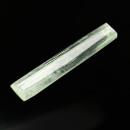|
|
|
|
Click on a letter above to view the list of gems. |
|
|
|
|
|
Kernite |
|
| Chemistry: Na2B4O6(OH)3·3(H2O) | |
| Discovered
in 1927;
IMA
status: Valid (pre-IMA; Grandfathered). | ||
|
| ||
|
Classification |
|
|
| |
|
Borates | |
|
5/J.05-10 | |
|
|
6 : BORATES |
|
Related to: |
Kernite Series |
|
|
|
|
Crystal Data |
|
|
|
|
|
Crystals commonly nearly equant, with over 30 forms noted; typically as cleavable masses, to 3.5 m, bent or warped; massive. |
|
|
On [011] |
|
|
|
|
|
Physical Properties |
|
|
|
|
|
[100] Perfect, [001] Perfect, [201] Fair |
|
|
Splintery |
|
|
Brittle; flexible and elastic in cleavage fragments |
|
|
2.5 |
|
|
1.906 (g/cm3) |
|
|
None |
|
|
Not Radioacitve |
|
|
Other: |
Slowly soluble in cold water, readily so in hot water. |
|
|
|
|
Optical Properties |
|
|
|
|
|
Colorless, White |
|
|
Transparent to Translucent |
|
|
Vitreous, Satiny on fibrous cleavages |
|
|
1.454 - 1.488 Biaxial ( - ) |
|
|
0.0340 |
|
|
Distinct; r > v |
|
|
X = colorless, Y = colorless, Z = colorless |
|
|
|
|
|
Occurances |
|
|
|
|
|
Geological Setting: |
An important ore mineral of borax in sedimentary borate deposits, deposited under warm conditions or formed by metamorphism. |
|
Common Associations: |
Borax, Colemanite, Inyoite, Ulexite |
|
Type Locality: |
Rich Station, Boron, Kramer District, Kern County, California, USA |
|
Year Discovered: |
1927 |
|
View mineral photos: | |
|
|
|
|
More Information |
|
|
|
|
|
| |
|
|
|
|
There
are only a couple sources for Kernite but the main source
for facetable crystals is from the Kramer borate deposite,
Boron, Kern County, California, USA which is also the
Type Locality. |
|
|
We
have not photographed our Kernite
gems. Please
check back soon. |

